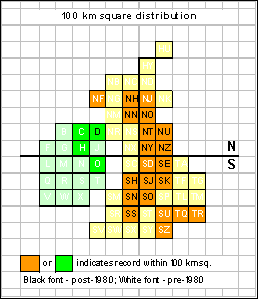Uncommon in Britain and Ireland
- ELIPSOCUS Hagen,1866
- abdominalis Reuter, 1904
- Elipsocus hyalinus (Stephens). Auct., following McLachlan, 1867 (not Elipsocus hyalinus Stephens)
- Elipsocus hyalinus var. abdominalis Reuter, 1904
- Elipsocus mclachlani Kimmins, 1941. Lienhard, 1985
- Elipsocus occidentalis Banks, 1907. Mockford, 1980
- Elipsocus abdominalis Reuter, 1904. Roesler, 1954
In 1867 Robert McLachlan provided an additional description for the species named Elipsocus hyalinus by Stephens thirty years earlier. This description has led to a good deal of confusion because it was clearly that of a different species. He summarised the key identification features noting that E. hyalinus was smaller than E. westwoodii (now E. pumilis) and “at once distinguished by its yellow abdomen, tipped with fuscous”, features which are not normally present in E. hyalinus. It was not until 1941 that this mistake was formally resolved by D.E. Kimmins who proposed the name E. mclachlani for the “small yellow-bodied species called ‘hyalinus Steph.’ by McLachlan and others.”
Consequently, records of E. hyalinus Stephens made prior to 1941 should be considered as E. mclachlani Kimmins (now E. abdominalis) whereas E. abietis Kolbe represents the genuine E. hyalinus. This information needs to become more widely known since some record-storing organisations are unaware of it.
The species has been widely known by the name E. mclachlani since this was used in the first British Psocoptera handbook (New, 1974) and was subsequently used in species dictionaries in the first commercial species recording software packages.
Studies of the characters of Elipsocus species found in the Rocky Mountains by Edward L. Mockford (1980) showed that E. mclachlani is synonymous with E. occidentalis Banks, 1907.
Charles Lienhard’s review of European Elipsocus species (Lienhard, 1985) demonstrated that E. occidentalis was in fact a synonym of E. abdominalis.

Existing records indicate that E. abdominalis is widespread in both north and south Britain. Further fieldwork will be required to discover whether the absence from south and west Ireland is real or apparent.
- Altitudinal range = 14 – 396m
- Number of pre-1980 records = c.26
- Number of post-1980 records = c.28
| Region |
Main date range |
Extreme dates |
| North |
Unknown |
10 July - 5 September |
| South |
Unknown |
19 June - 11 October |
Lienhard (1998) noted in the species account for E. abdominalis that in central Europe the adults are found between June and October and in general have two broods. These dates tie in well with the earliest and latest dates in south Britain (both records made in 100km square SO) and it seems likely that in the south the species is double-brooded.
As part of a study of the psocid fauna of larch trees in north Yorkshire Edward Broadhead (1958) captured specimens from a wide range of localities in two periods: a) early summer: 27 June-4 July 1955 and b) late summer: 8 August-24 September 1954. No specimens of E. abdominalis were caught in the early summer period compared to substantial numbers in the late summer. The date range for north Britain ties in well with this finding and strongly suggests that in the north the species is single-brooded.
More recording is needed to check and consolidate these findings and to provide a solid baseline to measure the impact of climate change (i.e. earlier appearances of adults at more northerly sites resulting in increased tendency for double-brooding). Regular recording at sites with strong populations would be particularly valuable for discovering the accurate adult periods (including annual fluctuations) across Britain.
Edward Broadhead (1958) and collaborators’ seminal work on psocids on larch in north Yorkshire in the 1950s included studies on feeding preferences. Their work concentrated on the seven commonest species that occurred in the study area which included E. abdominalis. This work showed that, unusually, E. abdominalis (and also Reuterella helvimacula)fed on the lichen Lecanora conizaeoides in preference to Pleurococcus/fungal spore mixtures. Further work showed that whereas R. helvimacula fed on the whole lichen, E. abdominalis only fed on the fructifying cups (apothecia) and did not eat the less palatable thallus, indicating that it was incompletely adapted to a lichen diet. Studies have also shown that E. abdominalis does not actively search for food. These two factors dictate that its abundance correlates closely to that of the lichen and Broadhead’s studies indeed showed that in the study area the two species both became progressively more abundant at higher altitudes (the lichen is more abundant due to the increased humidity).
Summary: has been found on branches and trunks of deciduous and coniferous trees.
Associations:
- Deciduous branches: birch, hawthorn and oak.
- Deciduous trunks: beech and oak.
- Conifer/evergreen branches: larch and yew.
Sampling techniques: beating branches and brushing tree trunks.
Broadhead, E. 1958. The psocid fauna of larch trees in northern England – an ecological study of mixed species populations exploiting a common resource. Journal of Animal Ecology 27: 217-263.
Kimmins, D.E. 1941. A list of the Psocoptera of Kent, Surrey and Sussex, with a revised list of the British species. Journal of the Society for British Entomology 2: 93-98.
Lienhard, C. 1985. Vorarbeiten zu einer Psocopteren-Fauna der Westpaläarktis. II. Die europäischen Arten der Gattung Elipsocus Hagen, 1866 (Psocoptera: Elipsocidae). Bulletin de la Société Entomologique Suisse 58: 113-127.
Lienhard, C. 1998. Psocoptères euro-méditerranéens. Faune de France 83, Paris.
McLachlan, R. 1867. A monograph of British Psocidae. Entomologist's Monthly Magazine 3: 177-276.
Mockford, E.L. 1980. Identification of Elipsocus species of western North America with descriptions of two new species. Pan-Pacific Entomology. 56(4): 241-259.
New, T.R. 1974. Psocoptera. Handbooks for the Identification of British Insects 1 (7), 102pp. Royal Entomological Society of London.
New, T.R. 2005. Psocids Psocoptera (Booklice and barklice). Handbooks for the Identification of British Insects 1 (7) second edition, 146pp. Royal Entomological Society.